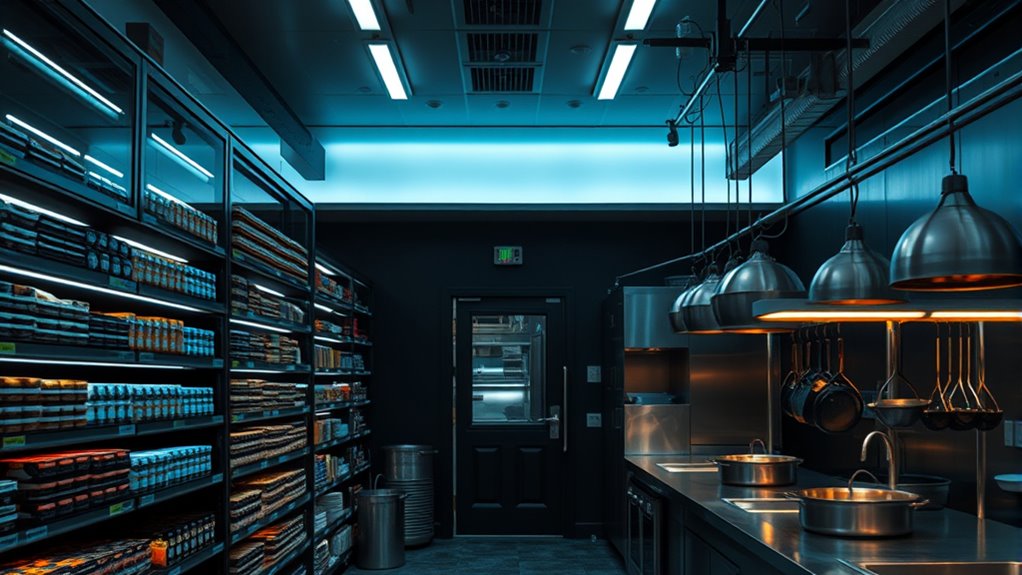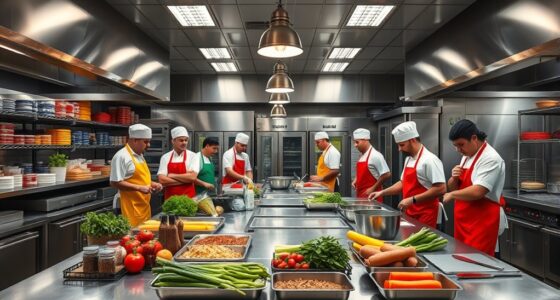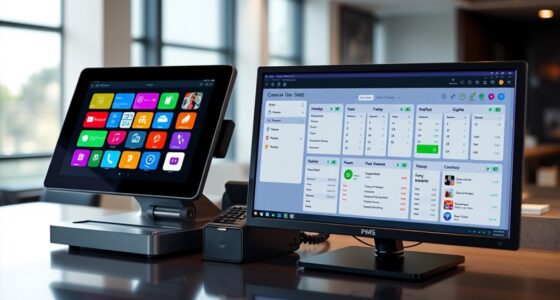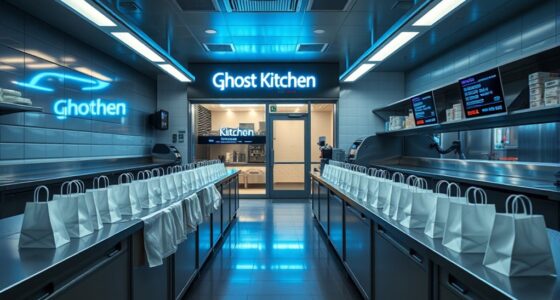Dark stores are retail spaces dedicated to fulfilling online orders, resembling supermarkets without public visitors, while ghost kitchens focus solely on preparing food for delivery or takeout, without dine-in options. Dark stores streamline product logistics, offering quick delivery of groceries and goods, whereas ghost kitchens optimize culinary operations for fast, high-quality meals. The key difference is their purpose—retail versus food prep—and understanding this helps you make better choices in food and shopping options as these models continue to evolve.
Key Takeaways
- Dark stores are retail outlets for online product fulfillment, while ghost kitchens are dedicated cooking facilities for food delivery.
- Dark stores resemble supermarkets without customer-facing storefronts, whereas ghost kitchens lack dining areas, focusing solely on food prep.
- Dark stores stock a wide variety of products for quick dispatch; ghost kitchens specialize in specific cuisines or brands for efficient meal production.
- Ghost kitchens generally have lower overhead costs by eliminating dine-in spaces; dark stores optimize retail logistics for faster delivery.
- Both models enhance delivery speed and customer experience but serve different roles in the food and retail industries.
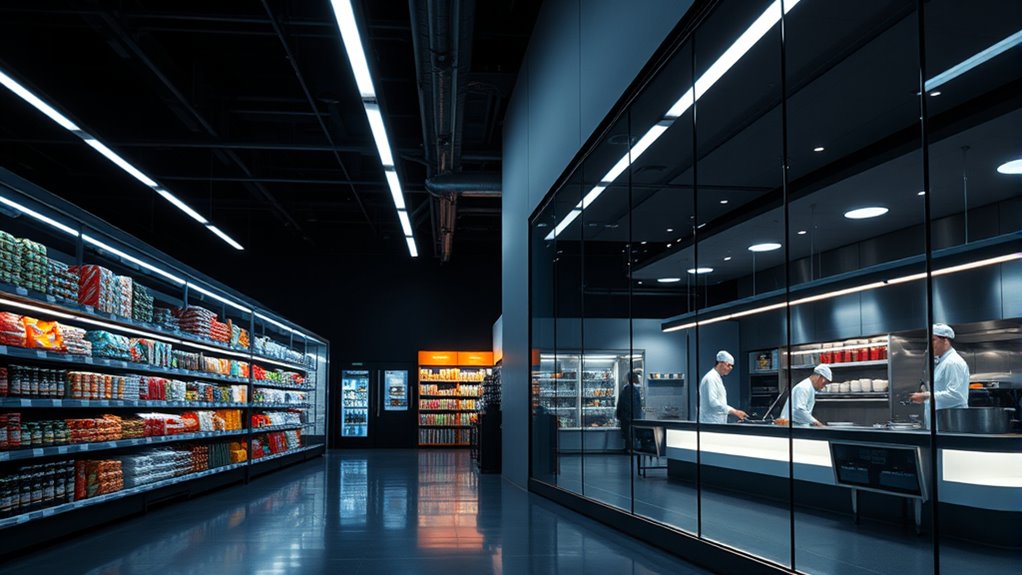
Dark stores and ghost kitchens are two innovative models transforming the food delivery landscape. As someone steering this evolving industry, understanding how they differ can help you make smarter decisions, whether you’re a restaurateur or a customer. Both models focus on streamlining operations and enhancing the customer experience, but they do so in unique ways.
Dark stores and ghost kitchens revolutionize food delivery through streamlined operations and enhanced customer experiences.
A dark store functions like a traditional retail outlet but operates solely for online orders. Think of it as a supermarket or convenience store without a storefront open to the public. Its primary goal is to optimize retail logistics—ensuring that products are stocked, organized, and ready for quick dispatch. This setup allows delivery drivers to pick up orders swiftly, reducing wait times and increasing efficiency. For you, the customer, this means faster delivery, fresher ingredients, and a broader product selection compared to traditional brick-and-mortar stores. The focus is on creating a seamless shopping experience that mirrors the convenience of online retail, but tailored for food and beverage delivery.
Ghost kitchens, on the other hand, are dedicated cooking facilities designed exclusively for fulfilling online orders. They don’t have a storefront or dining area; their purpose is strictly culinary. Here, the emphasis is on culinary efficiency and specialization. Chefs work in a space optimized for preparing multiple cuisines or brands simultaneously, which means you get a variety of restaurant-quality food without the need for a physical restaurant location. From a retail logistics perspective, ghost kitchens allow for better inventory management, reduced overhead costs, and quicker adaptation to changing customer preferences. They also facilitate a more consistent customer experience, as each kitchen is designed to meet high standards of quality and speed. For you, this translates into more reliable food delivery, often with a focus on specific cuisines or brands that can adapt quickly to trends.
While both models aim to improve the delivery process, their differences lie in their core functions. Dark stores act as behind-the-scenes retail hubs that support quick, efficient order fulfillment by stocking and dispatching goods. Ghost kitchens concentrate on culinary production, optimizing the cooking process to deliver high-quality meals directly to your door. Both enhance customer experience but do so through different means—dark stores by offering a broad variety of products in a retail setting, and ghost kitchens by focusing on cooking excellence and speed. Understanding these distinctions can help you appreciate the logistics behind your favorite food delivery services and recognize the innovative strategies shaping the future of food commerce. Additionally, battery technologies are increasingly playing a role in powering these delivery operations through innovations in sustainable energy, ensuring efficiency and environmental responsibility.
Frequently Asked Questions
How Do Licensing Requirements Differ Between Dark Stores and Ghost Kitchens?
You need to comprehend that licensing requirements for dark stores and ghost kitchens differ mainly in zoning regulations and insurance. Dark stores often face stricter zoning rules since they’re retail spaces, while ghost kitchens usually operate under foodservice licenses with different zoning allowances. Both require appropriate insurance, but ghost kitchens might need additional coverage for delivery operations. Always check local regulations to make certain of compliance for your specific setup.
What Are the Primary Safety Concerns for Dark Stores Versus Ghost Kitchens?
You should focus on food safety and employee safety in both dark stores and ghost kitchens. In dark stores, the primary concerns include proper storage, sanitation, and preventing cross-contamination, especially since they handle retail products. For ghost kitchens, prioritize hygienic food prep areas, temperature control, and safe handling practices. Ensuring clear safety protocols and regular training helps mitigate risks and protect both staff and customers in either setting.
How Does Customer Perception Vary Between Dark Store and Ghost Kitchen Brands?
You might notice that customer trust varies between dark store and ghost kitchen brands, often influenced by brand reputation. Customers generally feel more confident ordering from ghost kitchens if they see transparent, consistent branding, while dark stores can face skepticism about product quality and safety. Your perception depends on how well these brands communicate their standards and maintain transparency, which directly impacts your trust and loyalty.
What Are the Environmental Impacts of Dark Stores Compared to Ghost Kitchens?
You’ll find that dark stores tend to have higher environmental impacts due to increased packaging waste and energy consumption from larger physical spaces and inventory storage. Ghost kitchens, on the other hand, usually generate less packaging waste and consume less energy since they operate with smaller setups focused solely on food prep. If sustainability matters to you, ghost kitchens might be a greener choice with their streamlined operations.
How Do Delivery Logistics Differ Between Dark Stores and Ghost Kitchens?
You’ll find that delivery logistics differ considerably between dark stores and ghost kitchens. With dark stores, you prioritize optimized delivery routing and inventory management to handle larger stock and serve nearby customers efficiently. Ghost kitchens focus on rapid, on-demand delivery, often using smaller, dedicated vehicles. This setup allows for quicker turnaround times, but requires precise routing and inventory control to meet customer expectations without delays.
Conclusion
Ultimately, understanding the differences between dark stores and ghost kitchens helps you make smarter choices in food delivery. While dark stores focus on online retail, ghost kitchens prioritize preparing meals for delivery only. The theory that ghost kitchens are more adaptable for rapid growth holds true, giving you faster service and more diverse options. So, next time you order, appreciate the innovation behind these concepts that keep your food convenient and fresh.
